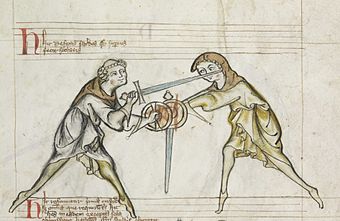Royal Armouries Ms. I.33
Jump to navigation
Jump to search

English: Royal Armouries Ms. I.33 (also known as "the Tower manuscript" because it was kept in the Tower of London during 1950-1996) is the earliest known surviving European fechtbuch (combat manual), and one of the oldest surviving martial arts manuals dealing with armed combat worldwide. It was created around 1300 in Franconia. It remained in a Franconian monastery (presumably in the Bishopric of Würzburg) until the mid-16th century. From the 17th century until 1945 it was kept in the ducal libarary of Gotha. It was looted at the end of WWII and bought by the Royal Armouries at an auction in 1950. The 64 page treatise shows a martial arts system of defensive and offensive techniques between a master and a pupil, referred to as sacerdos (priest) and scolaris (student), each armed with a sword and a buckler, drawn in ink and watercolour and accompanied with Latin text, interspersed with German fencing terms. On the last two pages, the pupil is replaced by a woman called Walpurgis.
Deutsch: Das I.33 Manuskript (Tower of London manuscript I.33, Royal library Museum, British Museum No. 14 E iii, No. 20, D. vi.; auch als "Tower-Fechtbuch" bekannt) ist das älteste bekannte Fechtbuch, entstanden um 1300. Es enthält Abbildungen und schriftliche Erklärungen für das Fechten mit dem Schwert und dem Buckler (Faustschild). Die Urheberschaft der Schrift wird allgemein einem deutschen Kleriker zugeschrieben, dessen Name als "Liutger" vermutet wird. Heinrich von Gunterrodt erwähnt das Manuskript zum ersten Mal im Jahr 1579.
-
01r
-
01v
-
02r
-
02v
-
03r
-
03v
-
04r
-
04v
-
05r
-
05v
-
06r
-
06v
-
07r
-
07v
-
08r
-
08v
-
09r
-
09v
-
10r
-
10v
-
11r
-
11v
-
12r
-
12v
-
13r
-
13v
-
14r
-
14v
-
15r
-
15v
-
16r
-
16v
-
17r
-
17v
-
18r
-
18v
-
19r
-
19v
-
20r
-
20v
-
21r
-
21v
-
22r
-
22v
-
23r
-
23v
-
24r
-
24v
-
25r
-
25v
-
26r
-
26v
-
27r
-
27v
-
28r
-
28v
-
29r
-
29v
-
30r
-
30v
-
31r
-
31v
-
32r
-
32v































































